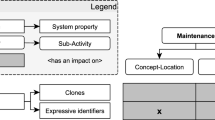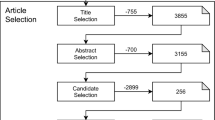Abstract
Product quality is directly related to how well that product meets the customer’s needs and intents. Therefore, the ability to capture customer requirements correctly and succinctly is paramount. Unfortunately, within most software development frameworks requirements elicitation, recording and evaluation are some of the more ill-defined and least structured activities. To help address such inadequacies, we propose a requirements generation model (RGM) that (a) decomposes the conventional “requirements analysis” phase into sub-phases which focus and refine requirement generation activities, (b) bounds and structures those activities to promote a more effective generation process, and (c) implements a monitoring methodology to assist in detecting deviations from well-defined procedures intended to support the generation of requirements that meet the customer’s intent. The RGM incorporates “lessons learned” from a preliminary study that concentrated on identifying where and how miscommunication and requirements omission occur. An industry study (also reported in this paper) attests to the effectiveness of the RGM. The results of that study indicate that the RGM helps (a) reduce the late discovery of requirements, (b) reduce the slippage in milestone completion dates, and (c) increase customer and management satisfaction levels.


Similar content being viewed by others
References
Royce WW (1970) Managing the development of large software systems: concepts and techniques. In: Proceedings of the Western electronic show and convention (WesCon), Los Angeles, California, August 1970, pp 1–9 (Reprinted in: Proceedings of the 9th international conference on software engineering, Monterey, California, March 1987, pp 328–338)
Boehm BW (1988) A spiral model of software development and enhancement. IEEE Comput 21(5):61–72
Agresti WW (1986) New paradigms for software development. In: IEEE tutorial series. IEEE Computer Society Press, Los Angeles
Connel JL, Shafer LB (1989) Structured rapid prototyping: an evolutionary approach to software development. Yourdon Press, Prentice Hall Building, Englewood Cliffs
Bravo E (1993) The hazards of leaving out the users. In: Schuler D, Namioka A (eds) Participatory design: principles and practices. Lawrence Erlbaum Associates, Hillsdale, pp 3–11
Freedman DP, Weinberg GM (1990) Handbook of walkthroughs, inspections, and technical reviews: evaluating programs, projects, and products, 3rd edn. Dorset House Publishing Company, New York
Greenbaum J (1993) A design of one’s own: towards participatory design in the United States. In: Schuler D, Namioka A (eds) Participatory design: principles and practices. Lawrence Erlbaum Associates, Hillsdale, pp 27–37
Davis AM (1993) Software requirements: objects, functions, and states. 2nd revised edn. Prentice-Hall, Englewood Cliffs
Davis AM (2003) The art of requirements triage. IEEE Comput 36(3):42–49
Herlea DE, Jonker CM, Treur J, Wijngaards NJE (2002) A compositional knowledge level process model of requirements engineering. Int J Softw Eng Know 12(1):41–75
Ambler SW (2002) Agile modeling: effective practices for XP and RUP. Wiley, New York
Ambler SM (2002) An introduction to agile modeling (AM). White paper, Ronin International. http://www.ronin-intl.com/publications/agileModeling.pdf
Boehm B, Egyed A, Kwan J, Port D, Shah A, Madachy R (1998) Using the WinWin spiral model: a case study. IEEE Computer 31(7):33–44
Bjerknes G, Tone Bratteteig (1995) User participation and democracy: a discussion of Scandinavian research on system development. Scand J Inf Syst 7(1):73–98
Wood J, Silver D (1995) Joint application development, 2nd edn. Wiley, New York
Mullery G (1979) CORE: a method for controlled requirements specifications. In: Proceedings of the 14th international conference on software engineering, Munich, Germany, pp 126–135
Richards D (2003) Merging individual conceptual models of requirements. Requirements Eng J 8(4):195–205
Easterbrook S, Nuseibeh B (1996) Using viewpoints for inconsistency management. Software Eng J 11(1):31–43
Finkelstein A, Gabbay D, Hunter A, Kramer J, Nuseibeh B (1994) Inconsistency handling in multi-perspective specifications. IEEE Trans Software Eng 20(8):569–578
Leite JCSP, Freeman PA (1991) Requirements validation through viewpoint resolution. IEEE Trans Software Eng 17(12):1253–1269
Sommerville I, Sawyer P, Viller S (1998) Viewpoints for requirements elicitation: a practical approach. In: Proceedings of the 3rd IEEE international conference on requirements engineering (ICRE ’98), Colorado Springs, Colorado, April 1998, pp 74–81
Davis AM, Hickey AM (2002) Requirements researchers: do we practice what we preach? Requirements Eng J 7(2):107–111
Fagan ME (1976) Design and code inspection to reduce errors in program development. IBM Syst J 15(3):182–211
Lewis RO (1992) Independent verification and validation: a life cycle engineering process for quality software. Wiley, New York
Ebenau RG, Strauss SH (1993) Software inspection process. McGraw-Hill, New York
Grudin J (1994) Groupware and social dynamics: eight challenges for developers. Commun Assoc Comput Machinery (CACM) 37(1):92–105
Nunamaker JF, Dennis AR, Valacich JS, Vogel DR, George JF (1991) Electronic meeting systems to support group work. Commun Assoc Comput Machinery (CACM) 34(7):30–61
Groener MK, Arthur JD (2002) Confirming the effectiveness of the requirements generation model: an industry-based empirical study. In: Proceedings of the 12th annual Pacific Northwest software quality conference, Portland, Oregon, pp 221–230
Arthur JD, Groener MK, Hayhurst KJ, Holloway CM (1999) Evaluating the effectiveness of independent verification and validation. IEEE Comput 32(10):79–83
Laeusen S, Vinter O (2001) Preventing requirements defects: an experiment in process improvement. Requirements Eng J 6(1):37–50
Rogers RA, McCaugherty D, Martin F (2001) A case study of IV&V return on investment (ROI). White paper, Titan Systems Corporation, Civil Government Services Group.http://titansystemscorp.com/groups/cgsg/techpapers/IVV_roi_case.pdf
Author information
Authors and Affiliations
Corresponding author
Rights and permissions
About this article
Cite this article
Arthur, J.D., Gröner, M.K. An operational model for structuring the requirements generation process. Requirements Eng 10, 45–62 (2005). https://doi.org/10.1007/s00766-004-0196-2
Received:
Accepted:
Published:
Issue Date:
DOI: https://doi.org/10.1007/s00766-004-0196-2




